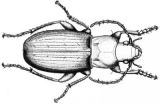(Press-News.org) Sept. 11, 2014 - New research from Arizona State University and the University of Tokyo that analyzes transmission rates of Ebola in West African countries shows how rapidly the disease is spreading.
Researchers Gerardo Chowell-Puente, ASU School of Human Evolution and Social Change Associate Professor, and Hiroshi Nishiura of the University of Tokyo found that transmission rates for each single case of Ebola consistently showed at least one new case of the disease being transmitted. Country-specific analysis of transmission rates in Liberia and Sierra Leone showed on average between one and two new cases for every existing case.
"Our analysis of the reproduction numbers of Ebola cases shows continuous growth from June to August 2014 that signalled a major epidemic," Nishiura said. "Uncontrolled cross-border transmission could fuel a major epidemic to take off in new geographical areas as was seen in Liberia."
Rates of transmission increased from June to July in Sierra Leone and Liberia from 1.4 to 1.7 respectively for every existing case. The statistical analysis is detailed in the paper, "Early transmission dynamics of Ebola virus disease, West Africa, March to August 2014," published today in Eurosurveillance.
"Our findings suggest that control of the Ebola epidemic that has taken so many lives could be attained by preventing more than half of the secondary transmissions for each primary case. This could be attained by isolating those with Ebola and tracing each case to its source," Chowell said.
The current epidemic is the largest and first regional outbreak of Ebola in Africa. The outbreak was not recognized until March of 2014 after starting around December of 2013, which facilitated the spread to Sierra Leone, Liberia and Nigeria. The World Health Organization declared the epidemic a Public Health Emergency of International Concern in August.
"Characterizing the distribution of secondary cases from a single case can help healthcare workers and officials understand Ebola transmission dynamics over time in affected countries and gauge the effect of interventions to control spread of the disease," he added.
Researchers analyzed case counts by the World Health Organization as of Aug. 26, 2014. Two groups of data were used: confirmed and probable cases; and the total number of reported cases (confirmed, probable and suspected cases).
Transmission rates are consistent with the rate of spread from prior outbreaks in Central Africa, researchers found.
"Close monitoring of this evolving epidemic should continue in order to assess the status of the outbreak in real time and guide control interventions in the region," Chowell said.
INFORMATION:
For additional information, please contact the researchers at:
Gerardo Chowell-Puente gchowell@asu.edu
Hiroshi Nishiura nishiurah@m.u-tokyo.ac.jp
Associate Professor Chowell may be reached in Tokyo at +81 3 5841 3688 between the hours of 12 p.m. and 5 p.m. U.S. Mountain time. (An e-mail is preferred. Skype interviews are also available.)
Contact:
Julie Newberg
ASU Media Relations
(480) 727-3116
Julie.newberg@asu.edu
Ebola paper demonstrates disease transmission rate
New research from Arizona State University and the University of Tokyo that analyzes transmission rates of Ebola in West African countries shows how rapidly the disease is spreading
2014-09-11
ELSE PRESS RELEASES FROM THIS DATE:
Some male scientists willing to forsake careers for family
2014-09-11
One third of men in academic science are willing to scale back their careers to focus on family life, according to researchers.
While traditional fatherhood roles may be shifting, men in the male-dominated field of academic science, such as physics and biology, face significant challenges in trying to balance work and family life, said Sarah Damaske, assistant professor of labor and employment relations and sociology, Penn State. The majority of men studied spoke of the pull of fatherhood and a desire to spend more time with children, yet they also acknowledged that academic ...
Not enough vitamin B1 can cause brain damage
2014-09-11
MAYWOOD, Ill – (Sept. 11, 2014) A deficiency of a single vitamin, B1 (thiamine), can cause a potentially fatal brain disorder called Wernicke encephalopathy.
Symptoms can include confusion, hallucinations, coma, loss of muscle coordination and vision problems such as double vision and involuntary eye movements. Untreated, the condition can lead to irreversible brain damage and death, according to neurologists at Loyola University Medical Center.
In the developed world, Wernicke encephalopathy typically occurs in people who have disorders such as alcoholism and anorexia ...
Investigators from Montefiore and Einstein to present data at 2014 ASTRO Meeting
2014-09-11
NEW YORK (September 10, 2014) – Members of the Department of Radiation Oncology at Montefiore Einstein Center for Cancer Care (MECCC) and Albert Einstein College of Medicine of Yeshiva University's NCI–designated Albert Einstein Cancer Center will present new study findings at the 56th Annual Meeting of the American Society for Radiation Oncology (ASTRO) revealing the impact socioeconomic status has on radiation treatment compliance, predictive indicators for clinical outcomes and on radiation therapy duration and dosing recommendations. ASTRO is being held September 14 ...
Two new species of carabid beetles found in Ethiopia
2014-09-11
There are more than 150 species of beetles in the genus Calathus, 17 of which have only been found in the mountains of the Ethiopian Highlands. Now scientists have found two new ones — Calathus juan and Calathus carballalae — and have described them in Annals of the Entomological Society of America.
C. juan is named for Juan Novoa, the son of one of the authors, in recognition of his help on various beetle-collecting expeditions. Adults are black and shiny, and are 9.5-11.5 millimeters long. It was found under stones at the base of giant, tree-like plants called lobelias ...
How salt causes buildings to crumble
2014-09-11
This news release is available in German. Historic stone buildings are tourist magnets. The Jordanian rock city of Petra, the medieval town of Rhodes in the Aegean Sea and the sandstone temples at Luxor, Egypt, for example, attract hundreds of thousands of visitors each year. These cultural assets all have one thing in common: they suffer from weathering caused by salts. These crystallise inside the porous building materials and generate enough force for the stone to break or crumble. The same problem also occurs in concrete buildings in this country.
Researchers at ...
Ticks that vector Lyme disease move west into North Dakota
2014-09-11
According to the U.S. Centers for Disease Control, there are more than 300,000 cases of Lyme disease in the U.S. each year. Last year, most Lyme disease cases reported to the CDC were concentrated heavily in the Northeast and upper Midwest, with 96 percent of cases in 13 states. In fact, the disease gets its name from the northeastern town of Lyme, Connecticut, where it was first discovered.
However, a new article published in the Journal of Medical Entomology reports that the ticks that vector Lyme disease — Ixodes scapularis, also known as blacklegged ticks or deer ...
Increased access to nature trails could decrease youth obesity rates, MU study finds
2014-09-11
VIDEO:
Researchers at the University of Missouri and the University of Minnesota have found that local governments can help reduce youth obesity levels by increasing the amount and type of public...
Click here for more information.
COLUMBIA, Mo. – As youth obesity levels in America remain at record high levels, health professionals and policymakers continue to search for solutions to this national health issue. Now, researchers at the University of Missouri and the University ...
Study finds high protein diets lead to lower blood pressure
2014-09-11
(Boston)--Adults who consume a high-protein diet may be at a lower risk for developing high blood pressure (HBP). The study, published in the American Journal of Hypertension, by researchers from Boston University School of Medicine (BUSM), found participants consuming the highest amount of protein (an average of 100 g protein/day) had a 40 percent lower risk of having high blood pressure compared to the lowest intake level.
One of three U.S. adults has hypertension and 78.6 million are clinically obese, a risk factor for the development of hypertension. Because of the ...
New defense mechanism against viruses discovered
2014-09-11
This news release is available in German. When it comes to defence against viruses, the immune system has an arsenal of weapons at its disposal including killer cells, antibodies and messenger molecules, to name just a few. When a pathogen attacks the body, the immune system usually activates the appropriate mechanisms. However, some of the mechanisms do not have to be triggered; they are continuously active as a standing army. Researchers from ETH Zurich, in collaboration with scientists from the University of Bern, have now discovered a new form of this so-called ...
UM research reveals secrets of animal weapons
2014-09-11
MISSOULA – From antlers to horns, humans have long been fascinated by animals' ability to defend themselves with their natural-born weapons. But until now, no studies have directly tested whether those weapons perform better at the animals' own style of fighting than they would using the fighting style of another species. Researchers at the University of Montana recently discovered each species' weapons are structurally adapted to meet their own functional demands of fighting.
The groundbreaking research, conducted over the past year by UM doctoral student Erin McCullough ...
LAST 30 PRESS RELEASES:
Scientists boost cell "powerhouses" to burn more calories
Automatic label checking: The missing step in making reliable medical AI
Low daily alcohol intake linked to 50% heightened mouth cancer risk in India
American Meteorological Society announces Rick Spinrad as 2026 President-Elect
Biomass-based carbon capture spotlighted in newly released global climate webinar recording
Illuminating invisible nano pollutants: advanced bioimaging tracks the full journey of emerging nanoscale contaminants in living systems
How does age affect recovery from spinal cord injury?
Novel AI tool offers prognosis for patients with head and neck cancer
Fathers’ microplastic exposure tied to their children’s metabolic problems
Research validates laboratory model for studying high-grade serous ovarian cancer
SIR 2026 delivers transformative breakthroughs in minimally invasive medicine to improve patient care
Stem Cell Reports most downloaded papers of 2025 highlight the breadth and impact of stem cell research
Oxford-led study estimates NHS spends around 3% of its primary and secondary care budget on the health impacts of heat and cold in England
A researcher’s long quest leads to a smart composite breakthrough
Urban wild bees act as “microbial sensors” of city health.
New study finds where you live affects recovery after a hip fracture
Forecasting the impact of fully automated vehicle adoption on US road traffic injuries
Alcohol-related hospitalizations from 2016 to 2022
Semaglutide and hospitalizations in patients with obesity and established cardiovascular disease
Researchers ‘listen in’ to embryo-mother interactions during implantation using a culture system replicating the womb lining
How changing your diet could help save the world
How to make AI truly scalable and reliable for real-time traffic assignment?
Beyond fragmented markets: A new framework for efficient and stable ride-pooling
Can shape priors make road perception more reliable for autonomous driving?
AI tracks nearly 100 years of aging research, revealing key trends and gaps
Innovative techniques enable Italy’s first imaging of individual trapped atoms
KIER successfully develops Korea-made “calibration thermoelectric module” for measuring thermoelectric device performance
Diversifying US Midwest farming for stability and resilience
Emphasizing immigrants’ deservingness shifts attitudes
Japanese eels, climate change, and river temperature
[Press-News.org] Ebola paper demonstrates disease transmission rateNew research from Arizona State University and the University of Tokyo that analyzes transmission rates of Ebola in West African countries shows how rapidly the disease is spreading

